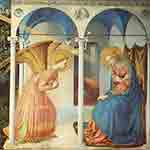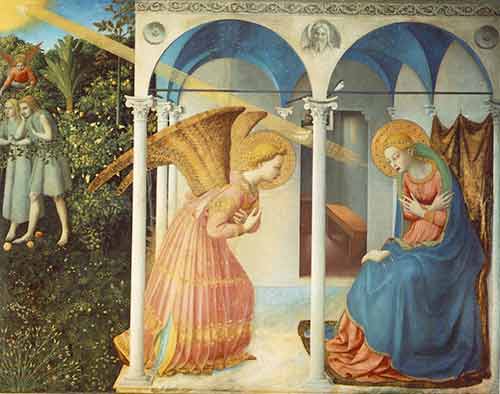We can waste time and energy, and generate more heat than light, about the Annunciation story – How much of it is history? Is it an extended metaphorical story? Where did Jesus’ other chromosomes come from?… And we miss the point of the story: God became what we are so that you and I might become what God is.
The incarnation reveals who God is. It reveals who we are. It complements what is meant by being made in God’s image: like a signet ring in wax, we are God’s image and our union can be complete. As we dig the wells of ourselves, with Jesus, there is no point where I stop and God starts.
From a historical perspective, we tend to take for granted that the date for Christmas was established and then we counted backwards – Jesus the perfect baby was perfectly 9 months in his mother’s womb. But actually, historically it may have been the other way around, with an ancient understanding that great events all occurred on the same date: creation, Abraham’s sacrifice of Issac, the incarnation, the crucifixion… In the West the calculation of the crucifixion came up with 25 March; in the East 6 April. So that’s the date of the incarnation. Calculate 9 perfect months forward and you have a birth in the West 25 December, and in the East 6 January.
This theory was first proposed by Louis Duchesne, Origines du culte Chrétien, 5th ed. (Paris: Thorin et Fontemoing, 1925), pp. 275–279; and developed by Thomas Talley, Origins of the Liturgical Year, 2nd ed. (Collegeville, MN: Liturgical Press, 1991).
Tertullian of Carthage notes that Jesus was conceived and crucified on the same day. St Augustine in On the Trinity (Sermon 202) also says: “[Jesus] is believed to have been conceived on the 25th of March, upon which day also he suffered; so the womb of the Virgin, in which he was conceived, where no one of mortals was begotten, corresponds to the new grave in which he was buried, wherein was never man laid, neither before him nor since. But he was born, according to tradition, upon December the 25th.”
The West would have started from the Hebrew 14 Nisan. The East from 14 Artemisios in the Greek calendar.
We do not know which theory of this day’s origin is correct: 9 perfect months before the solstice, or connecting incarnation and crucifixion. Both are worth our reflection on this day when we remind ourselves that God became what we are so that you and I might become what God is.
Pour your grace into our hearts, O Lord,
that we who have known the incarnation of your Son Jesus Christ,
announced by an angel to the Virgin Mary,
may by his cross and passion be brought to the glory of his resurrection;
who lives and reigns with you,
in the unity of the Holy Spirit,
one God, now and for ever Amen.
If you appreciated this post, consider liking the liturgy facebook page, using the RSS feed, and/or signing up for a not-very-often email, …
Instagram’s @liturgy is the new venture – if you are on Instagram, please follow @liturgy.





An old post, regarding the date of the Incarnation and Passion.
https://aclerkofoxford.blogspot.com/2016/03/this-doubtful-day-of-feast-or-fast-good.html
Thanks, Diegwu. Blessings.